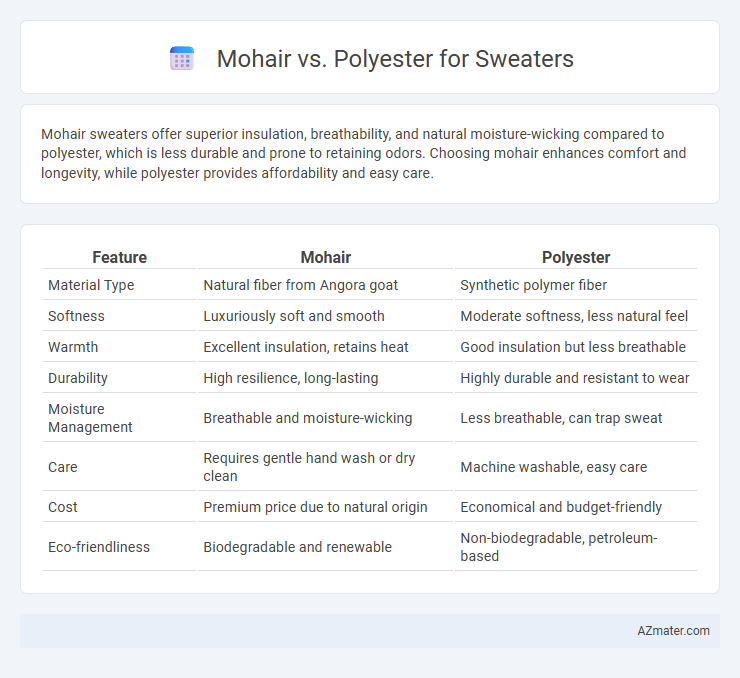Mohair sweaters offer superior insulation, breathability, and natural moisture-wicking compared to polyester, which is less durable and prone to retaining odors. Choosing mohair enhances comfort and longevity, while polyester provides affordability and easy care.
Table of Comparison
| Feature | Mohair | Polyester |
|---|---|---|
| Material Type | Natural fiber from Angora goat | Synthetic polymer fiber |
| Softness | Luxuriously soft and smooth | Moderate softness, less natural feel |
| Warmth | Excellent insulation, retains heat | Good insulation but less breathable |
| Durability | High resilience, long-lasting | Highly durable and resistant to wear |
| Moisture Management | Breathable and moisture-wicking | Less breathable, can trap sweat |
| Care | Requires gentle hand wash or dry clean | Machine washable, easy care |
| Cost | Premium price due to natural origin | Economical and budget-friendly |
| Eco-friendliness | Biodegradable and renewable | Non-biodegradable, petroleum-based |
Introduction: Mohair vs Polyester Sweaters
Mohair sweaters, made from the soft and durable hair of the Angora goat, offer superior warmth, breathability, and natural moisture-wicking properties compared to polyester sweaters. Polyester, a synthetic fiber, provides affordable durability and resistance to wrinkles and shrinking but lacks the natural insulation and comfort of mohair. Choosing between mohair and polyester sweaters depends on preferences for softness, temperature regulation, and sustainability.
What is Mohair?
Mohair is a luxurious fiber obtained from the Angora goat, prized for its exceptional softness, sheen, and insulating properties that make it ideal for high-quality sweaters. Its natural fibers have a unique ability to regulate temperature, providing warmth in winter and breathability in warmer conditions. Compared to polyester, a synthetic fiber made from petrochemicals, mohair offers superior comfort, durability, and moisture-wicking benefits, enhancing the sweater's overall performance and longevity.
What is Polyester?
Polyester is a synthetic fiber made from petroleum-based products, widely used in clothing for its durability, wrinkle resistance, and affordability. It offers moisture-wicking properties and quick drying, making it suitable for activewear and everyday sweaters. Compared to natural fibers like mohair, polyester is less breathable but more resistant to shrinking and stretching.
Warmth and Comfort Comparison
Mohair fibers, derived from the Angora goat, provide superior warmth and natural insulation compared to synthetic polyester, making mohair sweaters ideal for cold weather. Polyester offers durability and moisture-wicking properties but lacks the breathability and softness that mohair delivers, which enhances overall comfort. Choosing mohair ensures a cozy, luxurious feel with excellent heat retention, while polyester suits active wear requiring easy maintenance and quick drying.
Breathability and Moisture Management
Mohair fibers offer superior breathability and natural moisture-wicking properties, making sweaters more comfortable in varying temperatures by allowing air circulation and rapid moisture evaporation. Polyester sweaters, while durable and resistant to shrinking, tend to trap heat and moisture, leading to reduced breathability and potential discomfort during extended wear. High-quality mohair blends enhance temperature regulation, whereas polyester often requires special fabric treatments to improve its moisture management capabilities.
Durability and Longevity
Mohair fibers, derived from the Angora goat, exhibit exceptional durability and maintain their strength even when wet, resulting in long-lasting sweaters that resist pilling and wear. Polyester, a synthetic fiber, offers high tensile strength and resistance to stretching and shrinking but may degrade faster with repeated washing and exposure to heat. Sweaters made from mohair often provide superior longevity due to natural resilience, while polyester blends may require careful maintenance to preserve durability over time.
Maintenance and Care Requirements
Mohair sweaters require gentle hand washing or dry cleaning to preserve their softness and prevent fiber damage, with careful drying flat to avoid stretching. Polyester sweaters are easier to maintain, allowing machine washing and quick drying without shrinking or wrinkling. Mohair's delicate fibers demand more meticulous care, while polyester offers durable, low-maintenance convenience.
Environmental Impact: Mohair vs Polyester
Mohair is a natural fiber derived from Angora goats, offering biodegradability and lower environmental pollution compared to synthetic alternatives. Polyester, produced from petrochemicals, contributes significantly to microplastic pollution and relies heavily on non-renewable fossil fuels. The environmental impact of mohair is generally lower when considering biodegradability and renewability, whereas polyester's durability comes at the cost of greater ecological damage through production and waste.
Price and Affordability
Mohair sweaters typically come with a higher price tag due to the natural fibers and labor-intensive production process compared to polyester. Polyester sweaters offer a budget-friendly alternative with greater affordability, making them accessible for large-scale purchase and everyday wear. Consumers seeking luxury and durability may opt for mohair, while those prioritizing cost-effectiveness usually prefer polyester options.
Which Sweater Material Should You Choose?
Mohair sweaters provide superior warmth, breathability, and natural softness due to fibers from the Angora goat, making them ideal for luxurious, cozy wear and better moisture regulation. Polyester sweaters offer durability, affordability, and resistance to wrinkles and shrinkage but often lack the breathability and temperature regulation of natural fibers. Choosing between mohair and polyester depends on prioritizing natural comfort and insulation versus cost-effectiveness and easy-care properties in sweater materials.

Infographic: Mohair vs Polyester for Sweater
 azmater.com
azmater.com